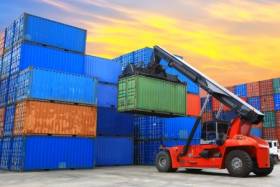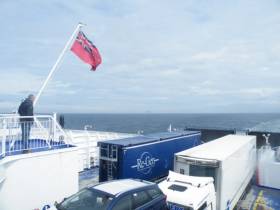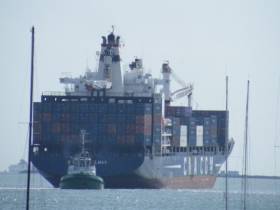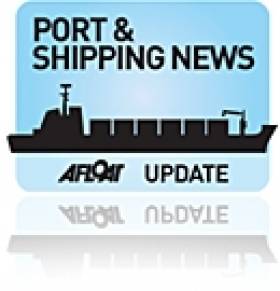Displaying items by tag: IMDO
Irish Shipping Volumes Rise By 1% In Q2 2017
#Shipping - Shipping and port activity in the Republic of Ireland rose by 1% in the second quarter of 2017 when compared to the corresponding period of 2016, according to the latest iShip Index published by the Irish Maritime Development Office (IMDO).
Unitised traffic — which consists of roll-on/roll-off (RORO) and lift-on/lift-off (LOLO) traffic — continued to rise, growing by 3% when compared to Q2 2016.
The majority of RORO traffic moves between Ireland and Great Britain, meaning this freight segment is a simple but reliable indicator as to the level of trade between both economies.
The RORO freight sector for the Republic of Ireland saw volume growth of 3% in the second quarter of 2017. This is the fifth consecutive Q2 increase in this freight category.
As for LOLO (containership) traffic, exports in the Republic of Ireland (ROI) rose by 7.4% compared to Q2 2016, while imports remained relatively unchanged — rising by 0.9%. Overall, LOLO traffic in ROI increased by 3.7% to 184,673 TEU.
When reviewing unitised traffic, it is worth noting that both LOLO and RORO freight segments move in an all-island setting. Therefore, when Northern Irish ports are included, all-island RORO volumes grew by 2% in Q2 2017.
All-island LOLO traffic grew by 3.5%, with all-island imports and exports rising by 1.1% and 6.6% respectively compared to Q2 2016.
NI RORO volumes grew by 2%, while NI LOLO traffic grew by 2.8%. This was driven primarily by 4% growth in NI LOLO exports.
The bulk traffic segment saw tonnage volumes decrease by 1% (excluding transhipments) in the Republic of Ireland when compared to the same period last year. This was driven primarily by a 3% fall in Dry Bulk tonnage.
Break bulk volumes grew by 3%, while liquid Bulk traffic remained stable compared to Q2 2016.
Summary of Shipping Volumes for Republic of Ireland:

Shipping Volumes Through Irish Ports Rise by 7% in Q1 2017
#iShipIndex- According to the iShip Index recently published by the Irish Maritime Development Office (IMDO) shipping and port activity in the Republic of Ireland rose by 7% in the first quarter of 2017 when compared to the corresponding period of 2016.
The latest analysis indicates that all five of the principal freight segments saw volume increases in the first quarter of 2017. Unitised traffic - which consists of Roll-on/Roll-off (Ro/Ro) and Lift-on/Lift-off (Lo/Lo) traffic - continued to rise, growing by 5% when compared to Q1 2016.
The majority of Ro/Ro traffic moves between Ireland and Great Britain, meaning this freight segment is a simple but reliable indicator as to the level of trade between both economies. The Ro/Ro freight sector for the Republic of Ireland saw volume growth of 7% in the first quarter of 2017.This is the fifth consecutive Q1 increase in this freight category.
As for Lo/Lo (containership) traffic, Lo/Lo exports in the Republic of Ireland (ROI) rose by 6% compared to Q1 2016, while Lo/Lo imports remained relatively unchanged – rising by 0.5%. Overall, Lo/Lo traffic in ROI increased by 3% to 174,248 TEU.
When reviewing unitised traffic it should be noted that both Lo/Lo and Ro/Ro freight segments move in an all-island setting. Therefore, when Northern Irish (NI) ports are included, all-island Ro/Ro volumes grew by 6% in Q1 2017. All-island Lo/Lo traffic grew by 0.7%, with all-island imports and exports rising by 0.4% and 1% respectively, compared to Q1 2016. NI Ro/Ro volumes grew by 5%, while NI Lo/Lo traffic contracted by 6%. This was driven primarily by an 11% drop in NI Lo/Lo exports.
The Bulk traffic segment saw tonnage volumes grow by 8% (excluding transhipments) in the Republic of Ireland when compared to the same period last year. This was driven primarily by an11% increase in Dry Bulk tonnage, as well as 10% growth in Break Bulk volumes. This is the largest level of Dry Bulk volume recorded since the iShip index began in 2007. The relatively large expansion in Dry Bulk reflects the fact that a high degree of volume fluctuation exists in this market when viewed on a quarterly basis. As for Break Bulk volumes, this is the largest quarter on quarter increase in this segment since Q2 2015.
*The iShip index is a volume index for all freight traffic moving to and from the Republic of Ireland. This does not include passengers or transshipment activity.
Declining Passenger Total from Britain and Continental Europe
#FerryFigures – According to the 14th edition of the Irish Maritime Transport Economist report launched today, there was a decline of 2.6% in ferry passenger numbers in 2016.
The figure relates to those travelling between the island of Ireland, Britain and continental Europe that amounted to 4.3 million passengers.
The report on Ireland’s maritime industry including freight, produced by the Irish Maritime Development Office (IMDO) also revealed that the largest decline in the ferry passenger traffic was recorded between the Republic of Ireland and Great Britain. In this operating region the decline in passenger numbers of 5% to 2.2 million was recorded last year.
This decline in sea passenger traffic is in contract to strong growth in air passenger traffic.
Car volumes to and from the island of Ireland also decreased by 1% in 2016, to 1.28 million.
A full copy of the report can be downloaded from this link.
Traffic in Irish Ports Remains Strong in 2016 Despite Challenging Trading Environment
#MaritimeReport - The 14th edition of the Irish Maritime Transport Economist report produced by the Irish Maritime Development Office (IMDO) on Ireland’s maritime freight industry was launched today.
The report shows that in 2016, total port traffic increased by 2%, with growth driven predominantly by unitised trade, Roll-on/Roll-off (RoRo) and Lift-on/Lift-off (LoLo) traffic, both of which grew by 7% in 2016.
Also highlighted in the report was an increase of 11% in the number of cruiseship calls to Irish ports, with 274 calls recorded in 2016, while (ferry) passenger numbers between the island of Ireland, Great Britain and continental Europe declined by 2.6% to 4.3 million passengers in 2016.
Key figures
· 2% increase in total port traffic recorded in 2016
· 7% increase in RoRo traffic to 1,073,403 freight units
· 7% increase in LoLo traffic to 916,852 TEUs*
· 5% decline in total bulk traffic, driven by reduced demand for oil, coal and other bulk commodities
· Overall passenger traffic declined 2.6% in 2016, but 11% increase in cruise vessel calls recorded
Freight traffic
The growth recorded in unitised trade, which is closely correlated with consumer demand, points to increased consumer confidence in the Irish economy in 2016. With over 80% of RoRo traffic moving between the Republic of Ireland and the United Kingdom, the growth in RoRo traffic recorded in 2016 is also a reliable proxy for the performance of trade between both economies, despite economic and political uncertainty in 2016.
In contrast, total bulk traffic, comprising dry bulk, liquid bulk and break bulk, fell by 5% in 2016 to 28.5 million tonnes. Dry bulk volumes fell by 1% to 15.8 million tonnes and liquid bulk volumes fell by 9% to 11.3 million tonnes in 2016, with demand for commodities in these categories such as animal feeds, fertilizer, coal and oil affected by relatively warm and dry weather conditions. Break bulk traffic fell by 5% to 1.4 million tonnes, mainly driven by a 40% decrease in shipment of refuse derived fuel. When these shipments are excluded, break bulk traffic grew by 2% in 2016, with increases recorded in the shipment of commodities such as cement, which underpin growth in the Irish construction sector.
Passenger traffic
Figures for 2016 show a decline of 2.6% in passenger numbers between the island of Ireland, Great Britain and continental Europe to 4.3 million passengers. The largest decline in passenger traffic was recorded between the Republic of Ireland and Great Britain, with a decline in passenger numbers of 5% to 2.2 million recorded in 2016. This decline in sea passenger traffic is in contract to strong growth in air passenger traffic in 2016. Car volumes to and from the island of Ireland also decreased by 1% in 2016, to 1.28 million.
Ireland’s cruise industry, however, recorded growth in 2016 with an 11% increase in vessel calls in 2016. 274 vessels called to Irish ports in 2016 carrying 442,304 passengers and crew. Dublin Port remained Ireland’s busiest cruise terminal with 109 vessel calls carrying 159,124 passengers and crew, a 7% increase in passenger traffic from 2015.
Speaking at the launch of the 14th edition of the Irish Maritime Transport Economist, Liam Lacey, Director, IMDO, said: “As a maritime nation and an economy, we are heavily dependent on seaborne transport to link Ireland to world markets. While 2016 was a challenging year for business, the overall increase in port traffic and strong growth in unitised trade demonstrates the resilience of Ireland’s maritime industry in continuing to meet the needs of our growing economy. While the impact of Brexit on the trading environment is not immediately apparent in bilateral trade volumes recorded between Ireland and the UK in the second half of 2016, our maritime industry is influenced by factors such as exchange rate fluctuations that will continue to evolve in 2017.”
A full copy of the report can be accessed here.
2017 Maritime Commerce Forum Heads for Dublin Docklands
#Forum - The 2017 Maritime Commerce Forum will take place as a lunch-time event held in Dublin on Thursday 9th March. The time for the forum is from 12.30pm – 2.30pm and will be held at The Marker Hotel, Grand Canal Square. The venue is located in the capital's 'Docklands' quarter.
The event will follow on from a series of meetings held last year to discuss opportunities for Ireland in the area of ship leasing, maritime finance and maritime taxation. Given important developments, such as Brexit, which have occurred since the last meeting, the Forum looks forward to bringing this group together to discuss key opportunities for Ireland in light of a changing global environment. To launch the Forum this year and as a guest speaker is Mr. Alan Dukes, Chairman, Asia Matters.
Alan Dukes is the Chairman and co-founder of Asia Matters. He was a member of the Dáil (lower House of the Irish Parliament) for twenty-one years and during his political career served as the Irish Minister for Agriculture, Finance, Justice and Transport and Energy and Communications.
Alan was Leader of the Fine Gael Party for three years and was Chairman of the Irish Parliament’s Foreign Affairs Committee. He is a former Governor of the International Monetary Fund and a former Governor of the World Bank.
In his work at Asia Matters, he is strongly committed to the importance of two way benefits in Asia Ireland bilateral trade relations.
To reserve a place at the event from the Irish Maritime Development Office, RSVP to [email protected] by this Thursday 2nd March.
iShip Index: Irish Ports and Shipping Volumes Q4 2016
#iShipIndex - The latest iShip Index published by the Irish Maritime Development Office (IMDO) shows that shipping and port activity in the Republic of Ireland fell by 2% in the fourth quarter of 2016 when compared to the corresponding period of 2015 .
This contraction is largely explained by a 7% contraction in Bulk traffic which was in turn driven by a 10% fall in Dry Bulk freight. At the same time, Lift-on Lift-off (Lo-Lo) and Roll-on Roll-off (Ro-Ro) volumes, which are more closely correlated with consumer demand, rose by 6% and 5% respectively.
Breaking down the figures
Roll-on Roll-off (Ro-Ro) Traffic:
Over 80% of ROI Ro-Ro traffic moves between the United Kingdom (UK) and the Republic of Ireland (ROI). And is a reliable proxy for to the performance of trade between both economies.
In Q4 2016, total Ro-Ro traffic in the ROI grew by 7% , with volumes between the ROI and the UK Ro-up by 6%, while Ro-Ro traffic between ROI and Continental Europe saw a 10% rise against Q4 2015.
Lift-on Lift-off (Lo/Lo) Traffic:
In Q4 2016, laden Lo-Lo traffic in the ROI grew by 5% year on year. On a full year basis, laden Lo-Lo traffic increased by 6% compared to January – December 2015. Laden imports were up by 4%, while laden exports increased by 7%. When Northern Irish ports are included, laden Lo-Lo traffic growth was 5%. This figure was driven by laden import growth of 3%, and laden export growth of 7% for the island as a whole.
Bulk:
Total Bulk traffic for the ROI contracted by 7% in the 4th quarter of 2016. When Northern Irish ports are included, the contraction in total Bulk traffic for the island of Ireland was 4%.
The 7% drop in ROI bulk traffic was driven primarily by a 10% drop-off in Dry Bulk traffic. This market segment was particularly affected by a decline in volumes of coal and animal feed, down 51% and 9% respectively. Liquid bulk traffic in the ROI fell by 4% in Q4 2016, while ROI Break Bulk traffic saw 3% growth.
Offsetting the contraction in ROI Bulk, Northern Irish ports saw 6% growth in Total Bulk traffic in Q4, which meant that all island total bulk traffic fell by 4% when compared to the previous year.
There was a 2% drop in all-island Liquid bulk and a 5% drop in all-island Dry Bulk. All-island break bulk however, saw 5% growth, driven by an 11% increase in Northern Ireland Break Bulk traffic.
The Central Bank in its most recent bulletin noted that to date, due to the absence of any weakening in the U.K economy, the impact on the Irish economy has been through the volatility of the euro/sterling exchange rate. Forecasted GDP growth remains positive.
The Central Bank went on to say that while consumer sentiment (as measured by the ESRI consumer sentiment index) declined in Q4 2016, it has rebounded to its highest level since June 2016.
Tender For New ‘Umbrella Brand’ For Ireland’s Marine Sector
#BlueEconomy - The Irish Maritime Development Office (IMDO) is inviting tenders for the supply of services to develop a new ‘umbrella style’ brand identity for Ireland’s ‘blue economy’.
The new tender from the IMDO – the Government agency responsible for the development, promotion and marketing of the Ireland’s maritime sector – would involve the development of a brand story, guidelines and video to communicate Ireland’s overall marine offering on a B2B basis, both nationally and internationally.
The new brand identity is to be developed in support of the recently established Marine Development Team (MDT), a specific-purpose, Government-funded task force that will work in collaboration with a number of Government development agencies with the overall goal of developing Ireland’s ocean economy.
The closing date for responses is Tuesday 14 February. Find out more about this tender HERE.
IMDO Host Inaugural Ship Commerce Forum
#Forum - The Irish Maritime Development Office (IMDO) hosted an inaugural meeting of the Ship Commerce Forum as the first industry event of 2016. The event was held on Thursday 18th of February at Wilton Park House in Dublin.
The event entitled ‘Maritime Finance: Opportunities for Ireland’ was well attended with a broad spectrum of representatives from professional services firms, financial institutions, international shipping companies as well as representatives from international asset leasing companies based in Ireland.
The round table event was created to initiate an industry focused debate on the current opportunities for Ireland in the maritime finance industry as well as the barriers that exist. Discussion also considered how Ireland could become a centre for maritime finance leveraging on the established leasing support services and expertise available here.
The IMDO Director, Liam Lacey, put forward some broad questions centred around Ireland’s potential as a maritime finance hub. He spoke at length about Ireland’s strength as a location for Foreign Direct Investment and success in other industries, whilst at the same time drawing attention to the opportunities inherent in Ireland’s current underperformance in the Maritime sector.
After a period of intra table debate and presenting back ideas Yvonne Thompson, Tax Partner at PwC gave a summation of the night’s discussion and highlighted some of Ireland’s strengths which make us an ideal location for companies involved in Maritime Commerce.
Growth and development of Ireland’s Maritime Commerce sector is an important initiative which ties into government ambitions outlined in Harnessing Our Ocean Wealth, the IMDO aims to create a forum through which industry views can be channelled and lessons learned.
The forthcoming Harnessing Our Ocean Wealth will take place in Galway on the 1st of July as part of the Marine Institute’s 3rd annual event SeaFest 2016.
Shipping Volumes through Irish Ports up 12% During Q3 2015
#iShipIndexQ3 - Shipping and port activity in the Republic of Ireland rose by 12% in the third quarter of 2015 when compared with the same period in 2014.The figures are from the latest quarterly iShipIndex* published by the Irish Maritime Development Office (IMDO).
The latest analysis also indicates that all of the five principal freight segments grew during that period.
Unitised traffic, which consists of Roll-on/Roll-off (Ro/Ro) and Lift-on/Lift-off (Lo/Lo) traffic, continued to rise steadily and has now shown consistent growth for an extended period, with an average growth rate of 6% per quarter in unitised traffic since Q2 2013 as measured by the iShip Index.
The majority of Ro/Ro traffic moves between Ireland and Great Britain and this freight segment is a simple but reliable indicator of the level of trade between both economies. Encouragingly, the Ro/Ro freight sector saw volume growth of 6% in the third quarter to 254,068 units.
Lo/Lo laden imports have now risen for eight consecutive quarters, reaching 96,828 teu in Q3, 2015. Lo/Lo laden exports grew 0.4% from the previous quarter to reach 68,249 teu in Q3, 2015. Overall, Lo/Lo container traffic increased 2% to 165,076 teu in the same period.
When reviewing unitised traffic, it is worth noting that both Lo/Lo and Ro/Ro freight move in an all-Island setting. Therefore, when Northern Irish ports are included, all-island Ro/Ro volume grew by 5% in Q3 2015. All Island traffic in the Lo/Lo laden sector grew 3% overall, with imports rising 3% and exports by 4% for Q3 2015.
The overall bulk traffic segment saw tonnage volumes increase by 19%, excluding transhipments, when compared to the previous year. Liquid bulk increased substantially by 31%. However, this increase was driven to a large extent by a temporary anomaly in the market in Q3 2014. Break bulk, which largely consists of imports of construction and project related commodities, increased by 6%. Break bulk has now seen ten consecutive quarterly increases.
There was a 12% increase in dry bulk traffic for Q3 2015 with trade in cement and animal feed showing significant growth. However, there is a high degree of fluctuation in traffic volume typical in the dry bulk market when viewed on a quarterly basis.
Note: *The iShip index is a volume index for all freight traffic moved to and from the Republic of Ireland. This does not include passengers, and transshipment activity.
Note: All freight and passenger comparisons are done on a quarterly basis (Q3 2015 v Q3 2014).
Irish Ports & Shipping Volumes Up 7% During Q4 2014
#ShippingVolumes - Irish ports and shipping activity rose by 7% in the fourth quarter of 2014 when compared to the corresponding period of 2013.
The figures released today are from the quarterly iShip Index* published by the Irish Maritime Development Office (IMDO).
The latest analysis also indicates that four of the five principal freight segments grew in the second quarter of 2014.
The Ro/Ro freight segment experienced volume growth of 4% in the fourth quarter to 429,814 units and is the eighth consecutive quarterly increase in Ro/Ro traffic, the majority of which moves between Ireland and Great Britain and is a simple but reliable indicator of the level of trade between both economies.
Container traffic (Lo/Lo) grew by 8% to 157,077 units. Encouragingly, container imports have now risen for five consecutive quarters. Container exports continued to grow, increasing by 4% to 67,888 units.
The overall bulk traffic segment saw tonnage volumes increase by 7% when compared to the previous year. Break bulk, which largely consists of imports of construction and project related commodities, increased by 16%.
Break bulk has now seen seven consecutive quarterly increases. Liquid bulk also rose by 16% and dry bulk increased by 1%, having both experienced negative growth in recent quarters.
For a breakdown of figures for the previous quarter, Q3 of 2014, click HERE
*The iShip index is a volume index for all freight traffic moved to and from the Republic of Ireland. This does not include passengers or trans-shipment activity.
Note: All freight and passenger comparisons are done on a quarterly basis (Q4 2013 v Q4 2014).





























































